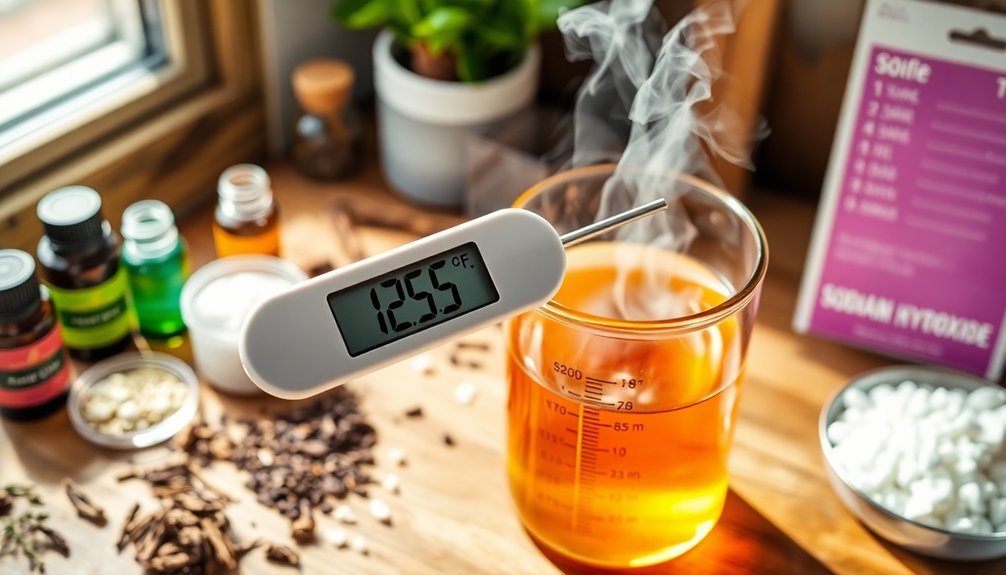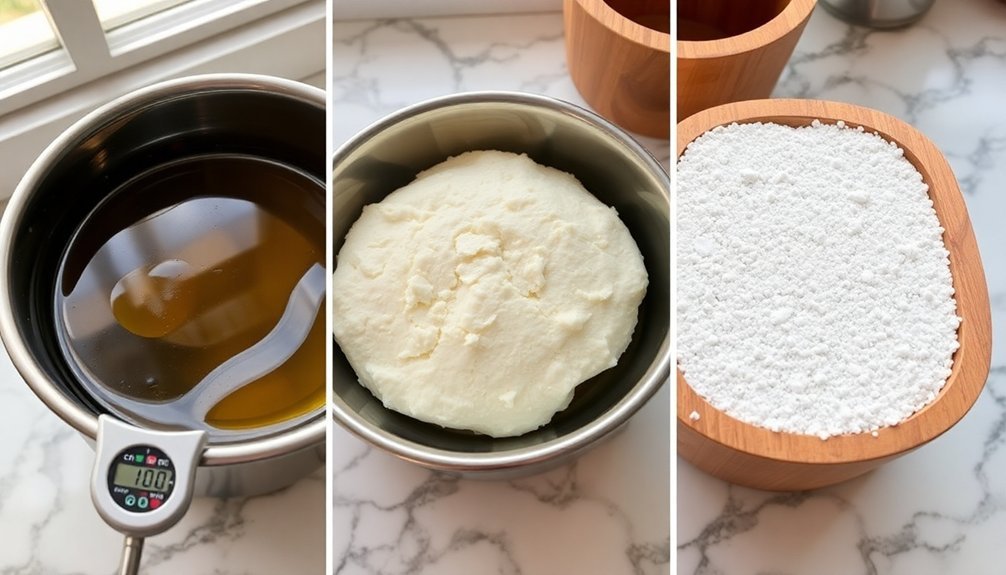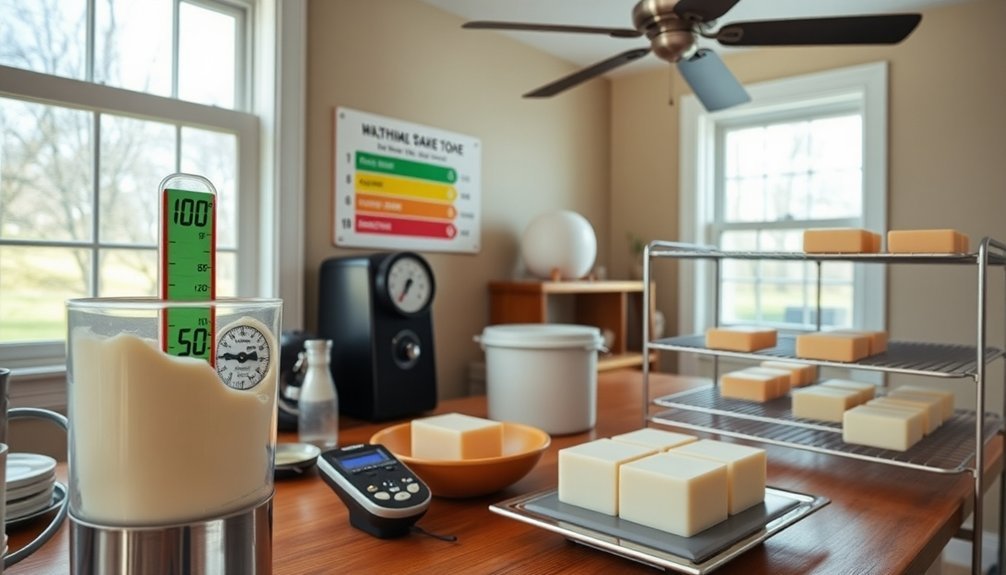When making soap, maintain your oils at 120-130°F and keep lye solution within 10°F of oil temperature. This sweet spot guarantees complete melting and prevents false trace issues. Cold temperatures below 100°F can cause graininess and soda ash, while excessive heat above 130°F risks acceleration and soap volcanos. Your room temperature should stay between 70-80°F for proper curing. Master these temperature zones and you'll eliminate the most common soap-making failures.
The Critical Oil Temperature Sweet Spot: 120-130°F

When making soap, hitting the right temperature for your oils is absolutely essential for success. The sweet spot for your soap making oils is precisely 120-130°F, which guarantees complete melting of all components in your oil mixture.
At this range, you'll avoid false trace issues that plague many beginners. You'll know you're in the best temperature zone when your oils appear clear and uniform—any cloudiness indicates solids that haven't fully melted.
For proper saponification process, you should also keep your lye temperatures within 10°F of your oils. This harmony between temperatures allows you to stick blend your soap effectively without premature thickening.
Confirming both your oils and lye solution maintain this temperature range creates the perfect environment for cold process soap making to proceed smoothly and predictably.
Lye Solution Temperature Management For Perfect Saponification
Although many soapers focus primarily on oil temperatures, managing your lye solution temperature is equally critical for successful saponification. Your lye solution should cool to 120-130°F before combining with oils—the same temperature range that's ideal for your fats.
When you mix lye with water, temperatures soar to 200°F, creating an exothermic reaction. Wait 1-3 hours for proper cooling, guaranteeing your solution and oils remain within 10°F of each other.
| Temperature | Cold Process Impact | Hot Process Impact |
|---|---|---|
| Too Hot (>140°F) | False trace, acceleration | Accelerated gel phase |
| Ideal (120-130°F) | Smooth soap batter | Controlled saponification |
| Too Cold (<110°F) | Oil solidification | Incomplete saponification |
| Mismatched | Separation, unsaponified lye | Inconsistent texture |
Never rush this cooling phase—proper temperature management prevents failed batches and guarantees complete saponification.
Cold Temperature Pitfalls: Preventing False Trace and Soda Ash

While experienced soapers might recognize the signs immediately, cold temperatures introduce two significant challenges that can ruin your batch before it even reaches the mold: false trace and soda ash.
False trace occurs when your soap batter prematurely thickens in cool conditions, creating a deceptive grainy texture that may separate in the mold. To prevent this frustrating issue, maintain your soaping temperature between 100-130°F for both lye solution and oils, ensuring they're within 10 degrees of each other for proper emulsification.
Similarly, soda ash forms when unsaponified lye reacts with carbon dioxide in cooler environments, causing a white powder on your soap's surface.
Monitor not just your ingredients but also your room temperature during cold process soap making. Keep oils completely clear and melted—cloudiness signals you're operating below ideal conditions.
Hot Temperature Hazards: Avoiding Acceleration and Soap Volcanos
The dangers of excessively hot temperatures lurk at every stage of the soap making process, potentially transforming your careful craft into a chaotic mess. When your temperature creeps into the 131-160°F range, be vigilant for accelerated saponification, which can cause your soap to thicken too quickly or seize unexpectedly.
To prevent soap volcanos, keep your lye solution and oils within 120-130°F. If you notice your mixture overheating during processing, quickly place your container in a cold water bath. This simple intervention can prevent unwanted gel phase anomalies and glycerin rivers from forming.
While pre-warming your oils can enhance saponification, exercise caution with heat sources. Excessive temperature won't only accelerate your reaction but might trigger defects that ruin your batch entirely.
Room Temperature Considerations For Consistent Curing Results

Beyond controlling temperatures during soap creation, your attention must now shift to the environment where your fresh soap will transform into its final form.
Maintain room temperature between 70-80°F to achieve ideal saponification and prevent soda ash formation on your soap's surface.
Cooler temperatures slow the curing process, resulting in softer soap that takes longer to harden properly. Conversely, warmer temperatures accelerate curing, risking overheating that can cause glycerin rivers or cracks in your finished product.
Ensure proper ventilation in your curing area to regulate both temperature and humidity, allowing your soap to dry evenly.
Regularly monitor ambient temperature and be prepared to relocate your soap if conditions change. These simple environmental controls greatly impact the quality of soap you'll ultimately produce.
Frequently Asked Questions
How Important Is Temperature in Soap Making?
Temperature is essential in your soap making process. You'll need to keep oils and lye within 120-130°F and within 10° of each other to guarantee proper emulsification and avoid problems like false trace or accelerated saponification.
What Is the Biggest Mistake First Time Soapmakers Make?
The biggest mistake you'll make as a first-time soapmaker is ignoring temperature control. When your oils and lye aren't within 40-45°C, you'll face false trace and uneven saponification, ruining your soap's quality.
What Is the Best Room Temperature for Soap Making?
You'll want to keep your room between 70-80°F (21-27°C) for ideal soap making. This temperature range guarantees proper saponification, prevents false trace, and helps you avoid separation issues or overheating problems in your soap.
What Is the Effect of Temperature on the Saponification Reaction?
Temperature directly impacts your saponification reaction rate. Higher temperatures accelerate the process, while lower temperatures slow it down. You'll need proper heat (120-130°F) to guarantee oils fully combine with lye for successful soap formation.
In Summary
You've now learned to navigate the critical temperature zones of soap making. Remember, keep oils at 120-130°F, manage your lye solution carefully, and avoid the pitfalls of both cold and hot extremes. By maintaining proper room temperature during curing, you'll consistently create beautiful, quality soap. Master these temperature zones, and you'll eliminate common mistakes that plague beginning soap makers.





Leave a Reply